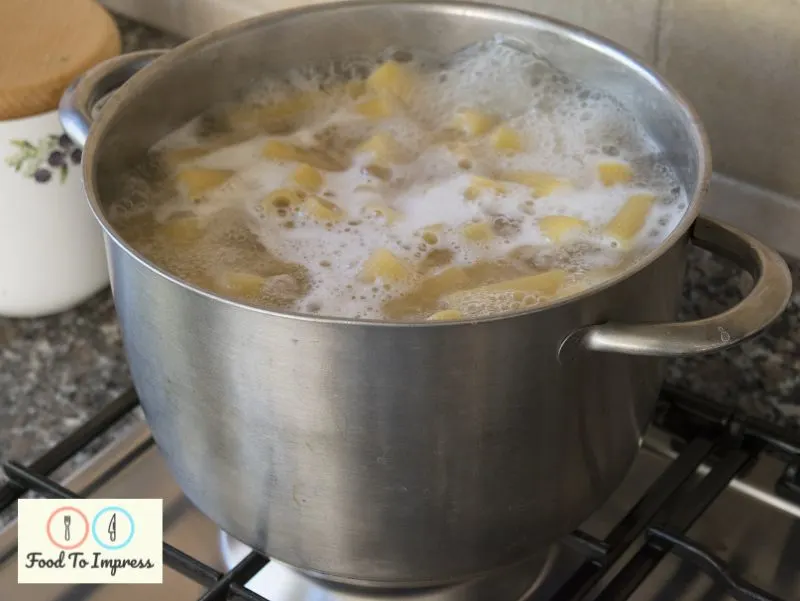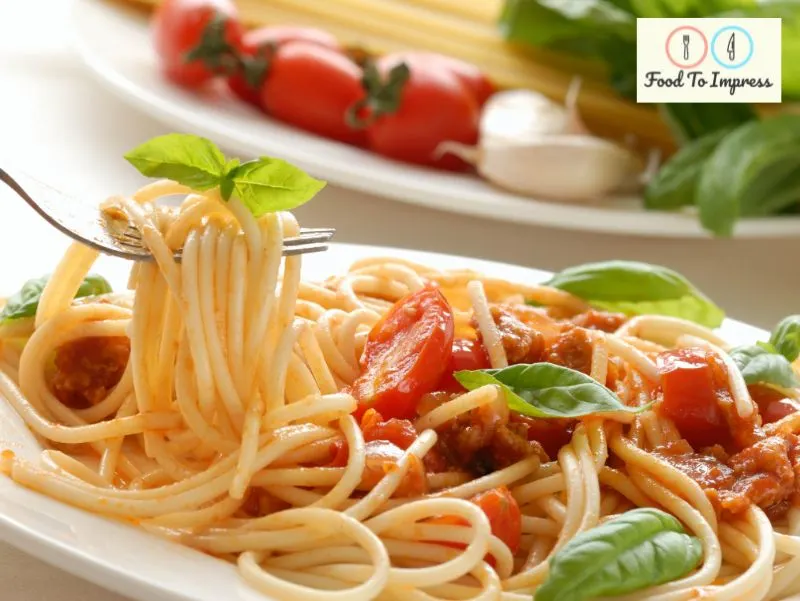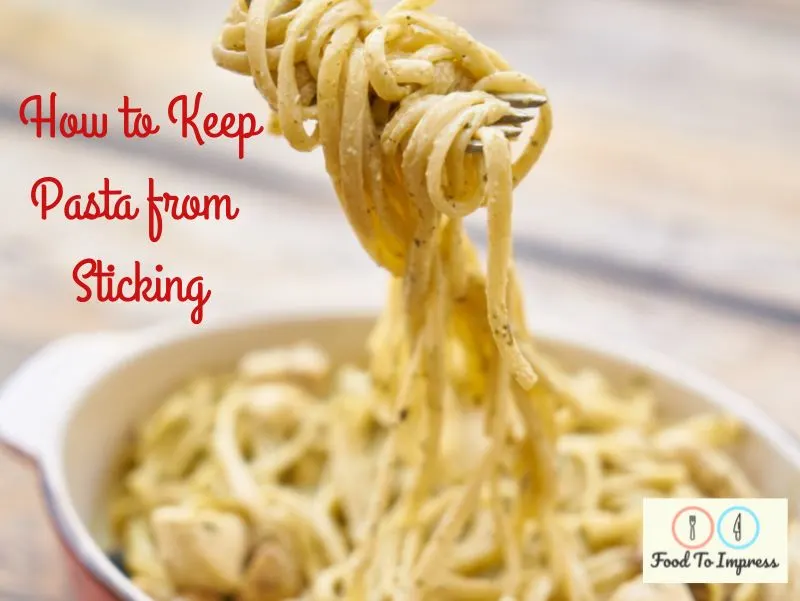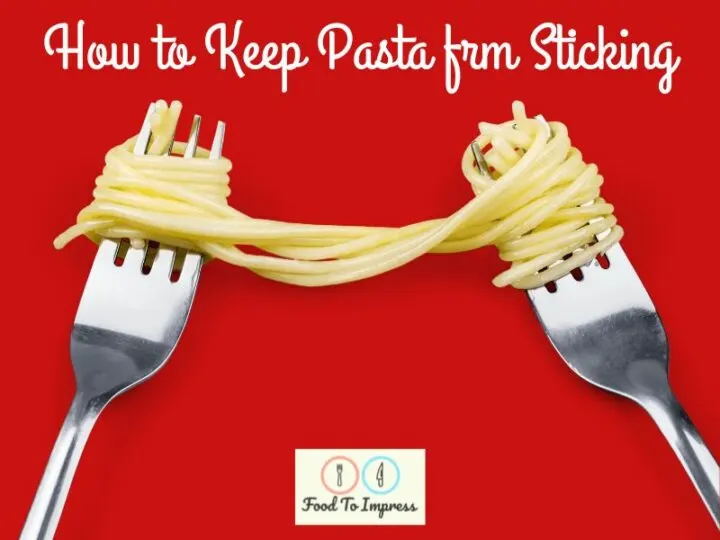We’ve all been in a situation where we’re cooking pasta one minute and all is going well, then you turn around for a few seconds and the pasta has adhered to the other pasta pieces, which is exactly what you don’t want. There are simple steps you can take to learn how to keep pasta from sticking together.
Pasta is a very simple and delicious dish, but it’s ruined by so many people when they use the wrong technique. If you don’t cook the pasta right, you’re going to run into this issue. There are many pasta dishes that are appreciated for their simplicity when cooked in the right way, but only when they’re made using the right techniques. Most people think of pasta as a basic meal that can be made by almost anyone, even the majority of college students. This, however, couldn’t be further from the truth.
To stop pasta from sticking, you need to use the right techniques. Be sure to add the pasta to boiling water, stir it often, and don’t overcook it. If you’re eating it with a sauce, the best thing you can do is finish cooking it in the sauce for a few minutes before serving.
How to Stop Pasta from Sticking
Although pasta seems very simple, the way you cook with it makes a huge difference. You can have perfectly cooked pasta and ruin it by not taking the right steps after boiling, leaving it to become a sticky lump of pasta mass. Let’s go through everything you can do to stop your pasta from sticking so you never have to worry about it again.
Once you get enough practice and figure out what properly cooked pasta is really like, you’ll get a good idea of when your pasta is ready to plate up and you’ll know what you can do to stop it from sticking completely. This may take lots of trial and error for some, so it’s just a matter of getting your technique down and understanding what good pasta is like.

Ways To Stop Pasta From Sticking
People use plenty of techniques to stop pasta from sticking to itself, but they aren’t all to be trusted. Some techniques are just complete pants and don’t work at all. The list below goes through all the proven ways to stop your pasta from sticking. These apply specifically to dried pasta.
How to Keep Pasta from Sticking – Stir It
The first few minutes of cooking are extremely important as this is when the pasta is most likely to stick. If not stirred, the pasta will release its starches and stick to other pieces of pasta, which is exactly what you’re wanting to avoid. Leave the lid off of the pasta when you are cooking it.
You need to make sure that you’re stirring your pasta at least every 30 seconds during the first 3-5 minutes of cooking, then stir it every minute or so. This is so you can distribute the dissolved starch evenly in the water instead of it staying on the pasta.
This is very important when it comes to learning how to stop spaghetti from sticking together. Spaghetti is a thinner pasta and is more prone to sticking together but stirring it often will prevent it.
Make Sure The Water Is Boiling Heavily
You need the pasta to be boiling heavily before you put the pasta in because the pasta will drop the temperature of the water, which can extend the cooking time.
Pasta will cook through completely at temperatures as low as 180°F (82°C), so despite common belief, the pasta really doesn’t need to be boiling during cooking (more about this later on).
Since the pasta lowers the water temperature, it’s smart to have it boiling before you add it into the water so the temperature doesn’t drop below 180°F. If the temperature does get lower than this, it’s not a huge issue, but the pasta will take longer to cook and you’ll need to stir it more.
One benefit to having a constant boil is that some small pasta will be aggravated by the boiling, which will mean that you technically won’t need to stir it as much. However, you’ll be using more energy to heat the water to its boiling point, so you may want to save energy by lowering the heat.
How to Keep Pasta from Sticking – Finish Cooking It In The Sauce
My personal favorite method to prevent sticking is to simply put the pasta in the sauce just before it’s finished cooking. After a few minutes, the pasta will be perfectly cooked, covered in sauce, and ready to eat. It’s great.
To do this properly, all you have to do is pull the pasta out of the water a couple of minutes before it’s fully cooked, then you just let the sauce finish cooking it for the next few minutes. It’s as easy as that.
When I do this, I either use a large slotted spoon, spider, or tongs (depending on the pasta type) to pull the pasta directly out of that starchy water. This allows some of the starches to get into the sauce, which can help to thicken it slightly and allow it to adhere to the pasta better.
You can still use a colander for this method, but you might want to reserve some pasta water in a cup before draining it. That’s if you’re wanting to use the starchy water of course.
You can also cook pasta in the sauce directly the whole time too!

Add The Pasta To The Sauce As Soon As It’s Cooked
If both your sauce and pasta are ready to use, you can completely stop sticking by simply throwing it in the pot and giving it a good coating.
This prevents sticking because there’s now sauce between each piece of pasta, which lubricates it and prevents that sticky starch from adhering to other pieces of pasta. This works great to stop spaghetti sticking together.
From here, all you have to do is plate up and you’re ready to eat.
Cook It Until Al Dente
So you can cook pasta to whatever doneness you want, just not overdone. When you overcook pasta, you’re making it softer and more likely to stick to other pieces of pasta.
The sticky starch combined with the overcooked pasta’s tendency to break down and you’ve got pasta that falls apart very easily and isn’t appealing in the slightest.
The best way to make sure your pasta is cooked is to taste a piece every minute after the 8-minute mark (or sooner for thinner pasta, like spaghetti). This means tasting for doneness at 8 minutes, 9, minutes, 10 minutes, etc. until it’s done.
If you pull the pasta and add it to your sauce just as it reaches al dente, it’ll be perfectly cooked by the time you come to serve it.
How to Keep Pasta from Sticking – Don’t Let It Sit In The Water Once It’s Cooked –
If you’ve been testing it for doneness and find that’s it’s perfect, don’t leave it in the water for any longer. This will just continue the cooking, so you’ll end up with overcooked pasta by the time you drain it.
Instead of leaving the pasta in the water while waiting for the sauce, have the sauce ready before the pasta is done. By doing this, you can quickly drain the pasta and sauce it up without having to worry about it overcooking.
Don’t Let It Sit In The Colander For Long
If you drain the pasta in a colander and let it sit, it’s very likely to stick since the starches will start to firm up between the pasta pieces.
Like I’ve already said, you need to have the sauce ready whilst the pasta is cooking, so you can drain it and add it to the sauce in less than a minute.
By doing this, you’re minimizing the risk of sticking and you’ll have great pasta.
Rinse The Pasta (Only If You’re Going To Chill It)
So this one only applies if you’re going to be making pasta for a cold dish.
If you’ve ever chilled pasta without rinsing it first, you’ll find that it turns into a single mass of pasta that you have to rip apart to separate. You just end up with torn pieces of pasta and it’s not pretty.
To prevent this, all you have to do is rinse it with cold water. This simply washes the excess starch off the surface of the pasta, which prevents it from sticking together during chilling. Doing this before making a cold pasta dish will make your life a lot easier.

Myths About How To Stop Pasta Sticking Together
Still wondering “why does my pasta stick together after cooking?” There are many cooking techniques that are widely considered to be correct and the best ways to cook, but then they get proven wrong or at least proven to be less effective or pointless. Those of you who know much about J Kenji López Alt will know that he’s taken plenty of cooking science or techniques and proven them to be wrong. He’s done it with pasta cooking too. Here’s an article where Kenji proves that some pasta cooking common techniques aren’t necessary.
You Need A Large Pot Of Water
I’m sure you’ve heard about how important a large pot of water is for cooking pasta. The truth is, it’s not all that important. Sure, it’s good if you’re making a lot of pasta, but it’s definitely not necessary for boiling dried pasta at home.
The idea behind a lot of water is so that the starches can be diluted enough to prevent the pasta from being sticky. The issue is that pasta can come out sticky whether it’s cooked in a large amount of water or a small amount.
Realistically, you can get away with cooking pasta in enough water to just cover the surface, but you need to make sure that you’re stirring it constantly. This constant stirring just ensures that you’re separating the pasta and preventing the starch from holding them together.
Cooking pasta like this helps to improve basic pasta sauces by thickening them and helping them to cling to the pasta easier.
Read more about this in the Serious Eats article linked above.
Use Oil To Stop Sticking
A lot of people still believe that this makes pasta less sticky, but that’s really not true.
The common logic behind this is that the oil will coat the pasta, meaning that nothing will stick to it. The problem people find with this is that the oil will prevent the sauce sticking to the pasta, which leaves you with plain pasta while the sauce slips down to the bottom of the plate.
What’s more likely to happen is that the oil will separate from the water, barely coming into contact with the pasta, which will make no difference to how sticky the pasta will be.
If you’re going to oil the pasta once it’s drained, you should steer clear of this too (unless you’re not having it with sauce). Although it does prevent the pasta from sticking when poured directly onto it, it also prevents anything from sticking to the pasta, so the sauce will slide off.
Your Water Needs To Be Boiling Constantly
This was a big surprise to me, so I’m sure many other people would be surprised too. I’ve always boiled my pasta water in the past because that’s just what I was taught, but it’s not necessary.
The starches in the pasta will absorb water from 180°F, meaning that they can cook completely at this temperature, which is quite a way off boiling temperature (212°F).
You can save energy and still get perfectly cooked pasta in the same amount of time. What’s not to love?
This article was based on the cooking of dried pasta. Fresh pasta cooks for far less time and often requires a slightly different technique to get right.

